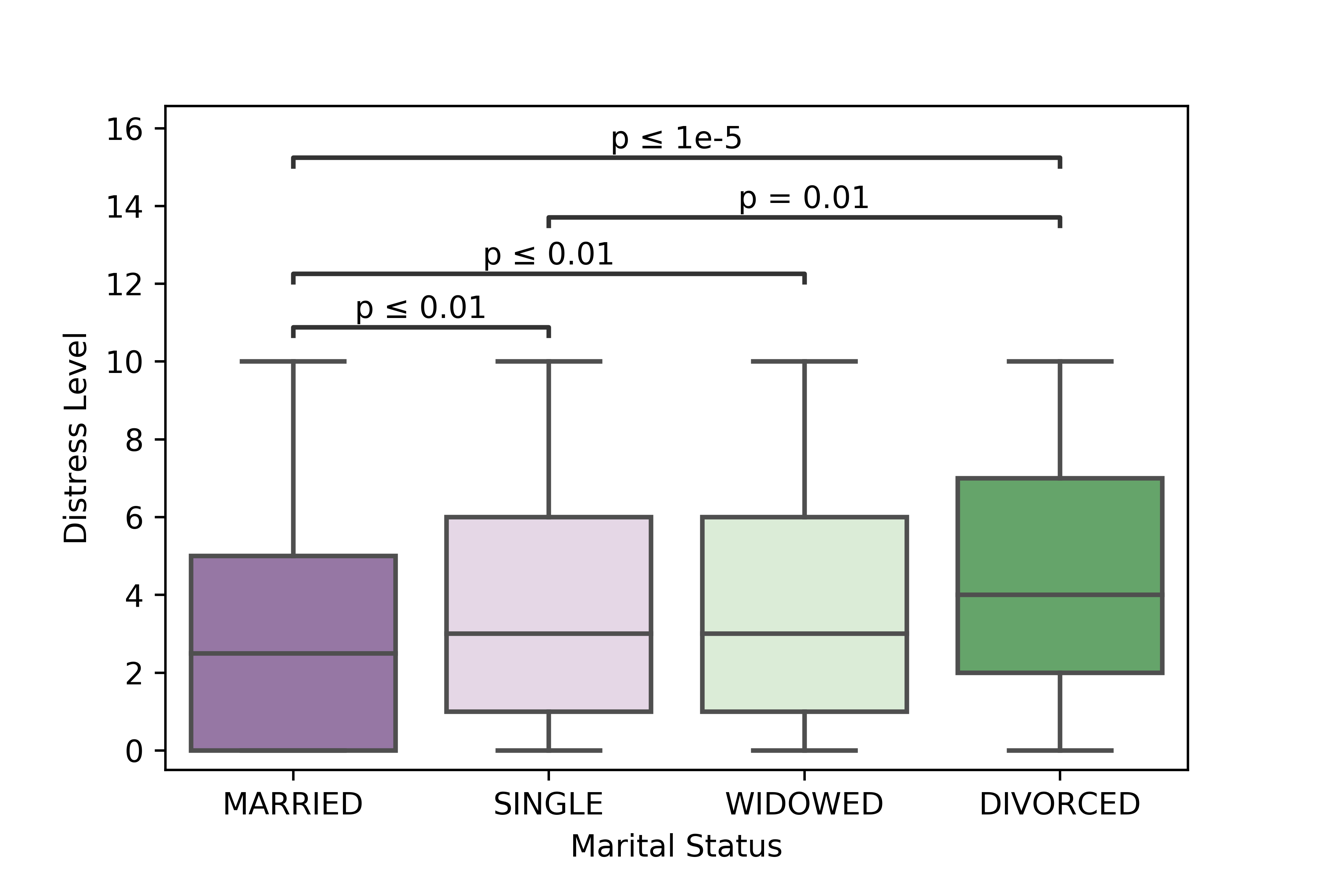Back
Poster, Podium & Video Sessions
Moderated Poster
MP13: Health Services Research: Practice Patterns, Quality of Life and Shared Decision Making I
MP13-19: Disparities in Distress for Patients with Cancer
Friday, May 13, 2022
2:45 PM – 4:00 PM
Location: Room 228
Connor Lough, BS*, Geoffrey Rosen, MD, Catherine Muzzey, RN BSN, Edward Johnson, Katie Murray, DO, Columbia, MO

Connor Patrick Lough, MD,BS
Urology Resident
University of Missouri - Columbia, School of Medicine
Poster Presenter(s)
Introduction: Distress negatively impacts quality of life for patients with cancer. The objective of this study is to identify sociodemographic characteristics associated with increased distress levels in patients presenting to our cancer center.
Methods: All patients at our center undergo a distress screening, reporting their distress on a 1-10 scale. We studied responses from 2020, and analyzed correlation with age, sex, race, and marital status. We used one-way ANOVA and performed pairwise t-tests if ANOVA demonstrated statistical significance.
Results: A total of 1,967 responses were considered. Mean distress levels in all new cancer center patients were higher in females than males (3.58 vs 3.12, p=.001). Those who identified as Black or African American had higher mean distress levels compared to those who identified as white (4.13 vs 3.36, p=.019). Marital status (Figure 1) was significantly associated with distress (p <.001), with married patients having lower mean distress (3.13) than those who identified as single (mean: 3.62, p=.004), divorced (mean: 4.30, p<.001), or widowed (mean: 3.92, p=.002). Divorced patients demonstrated a higher mean distress level than those who identified as single (p=.010). Age was associated with distress level (p=.010), with those <50 years demonstrating higher distress (3.68) than those between 60-70 years old (mean: 3.20, p=.010) and 70+ years old (mean: 3.22, p=.017). Additionally, those between 50-60 years old had higher mean distress levels (mean: 3.67) compared to those between 60-70 years old (mean: 3.20, p=.021) and 70+ years old (mean: 3.22, p=.032).
Conclusions: In patients presenting to our cancer center, we identified sociodemographic factors associated with increased distress levels. Young age, not being married, not identifying as white, and female gender were associated with increased distress. Future study should evaluate the role of disease characteristics and possible interventions on modifying distress levels.
Source of Funding: None.

Methods: All patients at our center undergo a distress screening, reporting their distress on a 1-10 scale. We studied responses from 2020, and analyzed correlation with age, sex, race, and marital status. We used one-way ANOVA and performed pairwise t-tests if ANOVA demonstrated statistical significance.
Results: A total of 1,967 responses were considered. Mean distress levels in all new cancer center patients were higher in females than males (3.58 vs 3.12, p=.001). Those who identified as Black or African American had higher mean distress levels compared to those who identified as white (4.13 vs 3.36, p=.019). Marital status (Figure 1) was significantly associated with distress (p <.001), with married patients having lower mean distress (3.13) than those who identified as single (mean: 3.62, p=.004), divorced (mean: 4.30, p<.001), or widowed (mean: 3.92, p=.002). Divorced patients demonstrated a higher mean distress level than those who identified as single (p=.010). Age was associated with distress level (p=.010), with those <50 years demonstrating higher distress (3.68) than those between 60-70 years old (mean: 3.20, p=.010) and 70+ years old (mean: 3.22, p=.017). Additionally, those between 50-60 years old had higher mean distress levels (mean: 3.67) compared to those between 60-70 years old (mean: 3.20, p=.021) and 70+ years old (mean: 3.22, p=.032).
Conclusions: In patients presenting to our cancer center, we identified sociodemographic factors associated with increased distress levels. Young age, not being married, not identifying as white, and female gender were associated with increased distress. Future study should evaluate the role of disease characteristics and possible interventions on modifying distress levels.
Source of Funding: None.


.jpg)
.jpg)